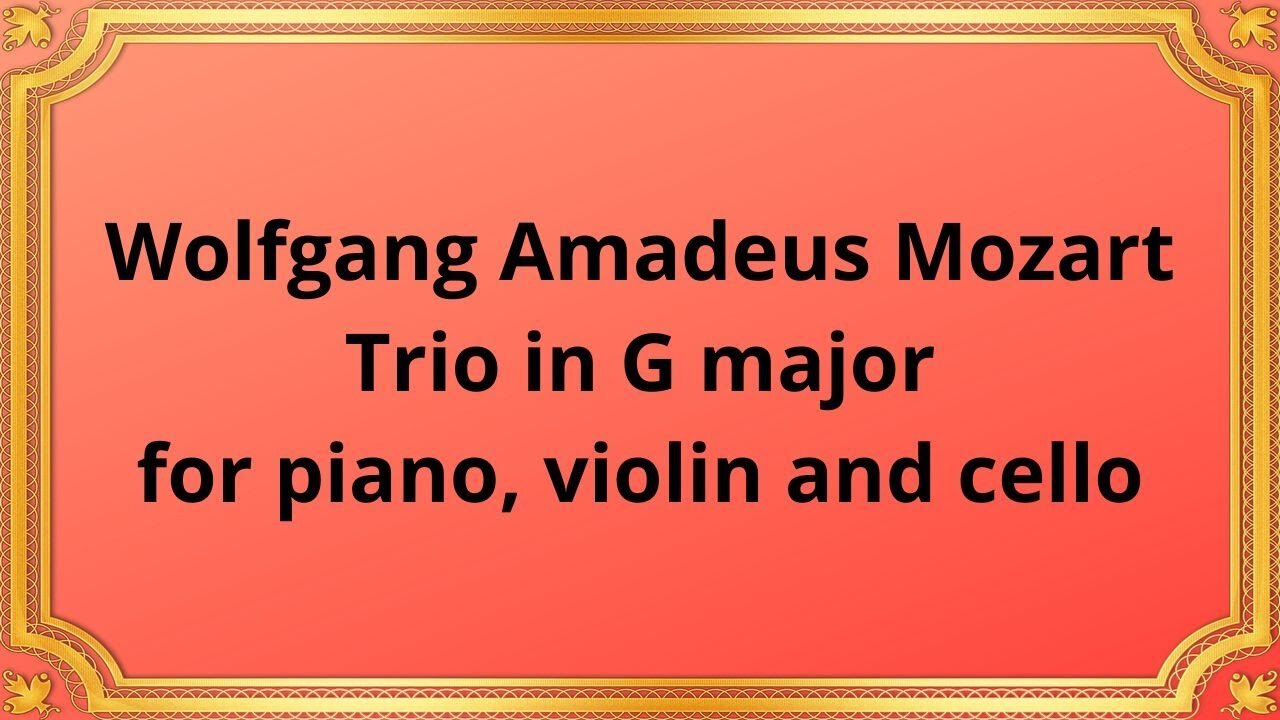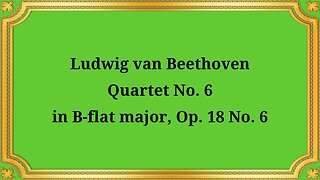Premium Only Content

Wolfgang Amadeus Mozart Trio in G major for piano, violin and cello
#Mozart #ClassicalMusic #TrioInGmajor #Piano #Violin #Cello #ChamberMusic #ClassicalTrio #MusicComposition #MusicHistory #ClassicalComposers #ClassicalPeriod #MusicAnalysis #MusicAppreciation
Annegret Diedrichsen, violin • Leonhard Hokanson, piano • Rudolf Klepac, bassoon • Eberhard Finke, cello
Wolfgang Amadeus Mozart, an esteemed composer of the Classical era, left an indelible mark on the world of music. One of his remarkable achievements is the Trio in G Major for piano, violin, and cello. This musical composition, written with exquisite craftsmanship, showcases Mozart's genius and continues to captivate audiences to this day.
To truly appreciate Mozart's Trio in G Major, it is crucial to understand the historical context in which it was composed. This piece was written in the late 18th century, during the height of the Classical period. Mozart, a prodigious talent, was renowned for his ability to effortlessly blend technical virtuosity with emotional depth. The Trio in G Major exemplifies the elegance and refinement that defined the Classical era.
The Trio in G Major follows the traditional structure of a four-movement chamber music composition. The first movement, marked "Allegro," introduces the main themes and sets the tone for the rest of the piece. The second movement, typically a slow and lyrical "Andante," provides a contrasting emotional landscape. The third movement, a lively and playful "Menuetto," showcases Mozart's knack for crafting delightful melodies. Finally, the fourth movement, an energetic "Rondo," brings the composition to a thrilling conclusion.
Mozart's Trio in G Major showcases his mastery of melody, harmony, and counterpoint. The piano, violin, and cello engage in a delightful interplay, each instrument contributing its unique voice to the overall composition. The melodies are beautifully crafted, showcasing Mozart's gift for creating memorable and expressive tunes. The harmonies are rich and sophisticated, creating a sense of depth and complexity. Additionally, the Trio in G Major demonstrates Mozart's skillful use of counterpoint, with the instruments engaging in intricate and intertwined melodic lines.
Mozart's Trio in G Major displays an impressive emotional range. From the triumphant and joyful moments in the first movement to the introspective and tender passages in the second movement, the composition takes listeners on a captivating journey. The lively and spirited third movement injects a sense of playfulness, while the finale brings a thrilling and exhilarating conclusion to the piece. Mozart's ability to evoke a wide spectrum of emotions is a testament to his musical genius.
The Trio in G Major continues to hold a significant place in the classical music repertoire. Its timeless beauty and intricate craftsmanship have ensured its enduring popularity. Musicians and audiences alike appreciate the elegance and technical brilliance displayed in this composition. The Trio in G Major serves as a testament to Mozart's remarkable talent and his contributions to the development of classical music.
Conclusion:
Wolfgang Amadeus Mozart's Trio in G Major for piano, violin, and cello stands as a testament to his brilliance as a composer. Through its captivating structure, masterful musical elements, and emotional depth, this composition continues to enthrall listeners across generations. The Trio in G Major remains a cherished work in the classical music canon, showcasing Mozart's unparalleled talent and leaving an indelible mark on the world of music.
You have the opportunity to support the channel:
https://destream.net/live/RadSiarAl/donate
https://www.buymeacoffee.com/6355radsiaral
-
 22:54
22:54
Classical music_Music Inspiration
7 days agoLudwig van Beethoven Quartet No. 6 in B-flat major, Op. 18 No. 6
262 -
 LIVE
LIVE
Kim Iversen
1 hour agoEPSTEIN VICTIM: We Have The Names. We'll Make The List.
2,012 watching -
 1:28:57
1:28:57
Redacted News
1 hour agoBREAKING! Putin's DEVASTATING news for Europe | Secret UFO Space Base in Huntsville | Redacted Live
63.4K43 -
 1:17:49
1:17:49
vivafrei
4 hours agoEpstein Press Conference DEBACLE! Missing Minute FOUND? Canada Continues to Fall! & MORE!
74.7K47 -
 29:30
29:30
Stephen Gardner
1 hour ago🟢YES! Trump’s Doing It! Ben Shapiro UNLEASHES on Democrat STUPIDITY!
19.5K9 -
 LIVE
LIVE
Dr Disrespect
6 hours ago🔴LIVE - DR DISRESPECT - METAL EDEN - NEW 2025 SCI-FI FPS LAUNCH STREAM
1,145 watching -
 LIVE
LIVE
StoneMountain64
4 hours agoBattlefield's Easter Egg Phantom Project is STILL ALIVE
134 watching -
 LIVE
LIVE
LFA TV
10 hours agoLFA TV ALL DAY STREAM - WEDNESDAY 9/3/25
1,489 watching -
 LIVE
LIVE
freecastle
6 hours agoTAKE UP YOUR CROSS- Love...Light...TRUTH!
171 watching -
 1:50:29
1:50:29
The Quartering
3 hours agoEpstein Victims To NAME People, Mutiny Over RFK Jr, Trump Turns On Warp Speed?
130K42